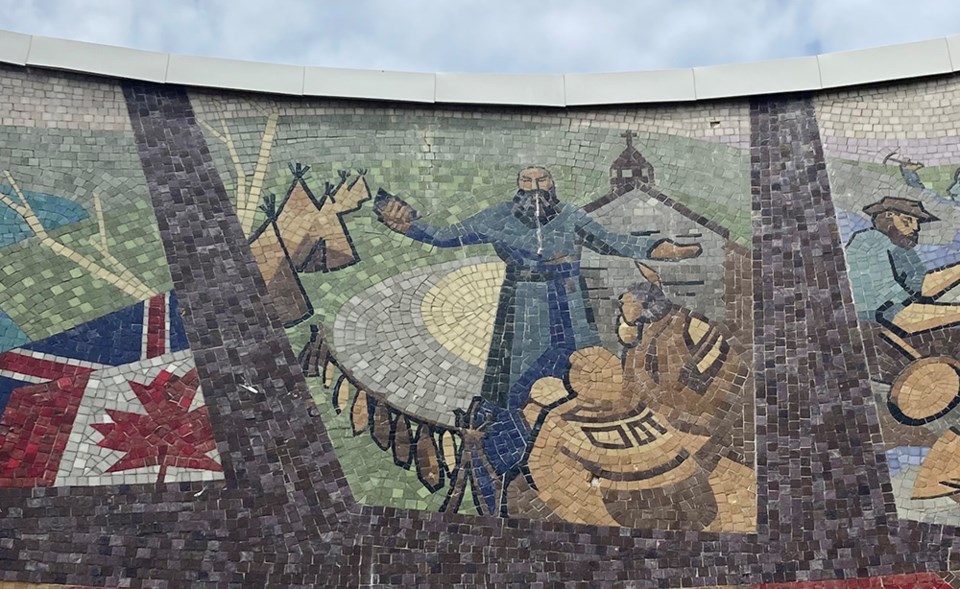Let’s try this again.
Four years ago, I called for the dismantling and removal of the mural in the middle of downtown Prince George that celebrates residential schools and the colonization of Indigenous peoples by white settlers.
It was the third time I had called upon a newly sworn-in city council to do something about that ugly disgrace next to Four Seasons Pool.
Maybe now, with the horrific discovery of 215 child victims at the Kamloops Residential School, Prince George city council will have the courage to act.
On Tuesday, while residential school survivors shared their stories to a crowd in front of city hall, about 100 metres away, the mural stood, a literal embodiment of systemic racism and whitewashed history.
It is not public art.
It is hateful propaganda.
It was put up in 1967 for Canada’s 100th anniversary to honour the brave settlers and celebrate everything they did to Indigenous peoples to build a future free of them and their influence.
Maybe now, Prince George city council will have the nerve to do something about this horrible edifice that is already crumbling from neglect.
The entire piece is offensive but two parts of it are not only racist but broadcast outright lies.
First, the centre top centre panel features Indigenous people dutifully sitting at the feet of a Christian missionary, who looms over them, while in the background, the church is much larger than the nearby teepees.
To imply that Indigenous peoples did not have deep and meaningful spiritual practices and a healthy, vibrant civilization before the settlers arrived is false.
The statement at the bottom of the mural speaks only the settler truth.
“They sought furs and the Pacific but found their future in the waiting forests.”
Who is “they?”
The mural’s placement and its continued existence within sight of City Hall at the heart of Prince George suggests this is the official and only acceptable version of history, that there was no history worth noting before settlers came to this region and that colonization saved Indigenous peoples from a pitiful existence.
On social media, several local residents are calling for the renaming of O’Grady Road in College Heights, named after John Fergus O’Grady, who was a priest at the Kamloops Residential School before coming to the Prince George diocese to serve as bishop.
UBC is already in the midst of revoking O’Grady’s honorary degree, bestowed upon him in the 1990s for his contributions to education.
Removing the centennial mural and renaming O’Grady Road (and while we’re at it, could something be done about Gladstone Drive, named after a British slave owner who had no connection to Canada or Prince George?) isn’t about rewriting history, it’s about righting history.
In that spirit, however, a word of caution is necessary.
For the settlers trying to be supportive by lashing out at the Catholic Church, please stop.
Tens of thousands of Indigenous Canadians, many of them elders and residential school survivors, remain devout Catholics to this day.
When Mary Gouchie, one of the Lheidli T’enneh’s most revered elders, died in 2019 at age 97, she received a full funeral mass at Sacred Heart Cathedral.
Yes, the Catholic Church should answer for its crimes. Prime Minister Justin Trudeau should make another formal invitation to the Vatican for Pope Francis to come to Canada and pray with the Indigenous members of his congregation, to hear their stories, to seek their forgiveness and to offer support and reparations.
In the meantime, there are easy, meaningful actions that Prince George city council can take to let residential school survivors in our community know they have been heard. This shouldn't be such a hard ask for the major city on the Highway of Tears. The city council in Charlottetown, the birthplace of Confederation, has ordered the removal of its statue of John A. Macdonald, Canada's first prime minister and a key architect of residential schools. The City of Calgary changed the name of a pedestrian bridge named after Hector-Louis Langevin, another Father of Confederation and residential school advocate, in 2017. This week, a student-led effort culminated in changing the name of a Calgary high school also named after Langevin.
After a practicing Catholic receives the sacrament of confession, he or she is asked to give penance through a small act of contrition, in exchange for forgiveness and the right to receive Holy Communion.
Removing the offensive mural and renaming O’Grady Road are two such small acts of penance for the City of Prince George to foster reconciliation and to recognize the horrible sin of residential schools.



